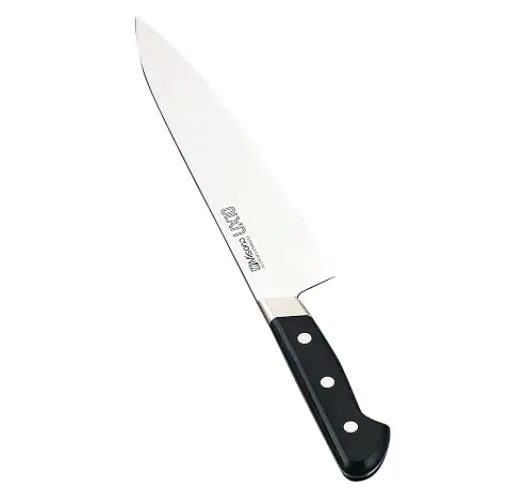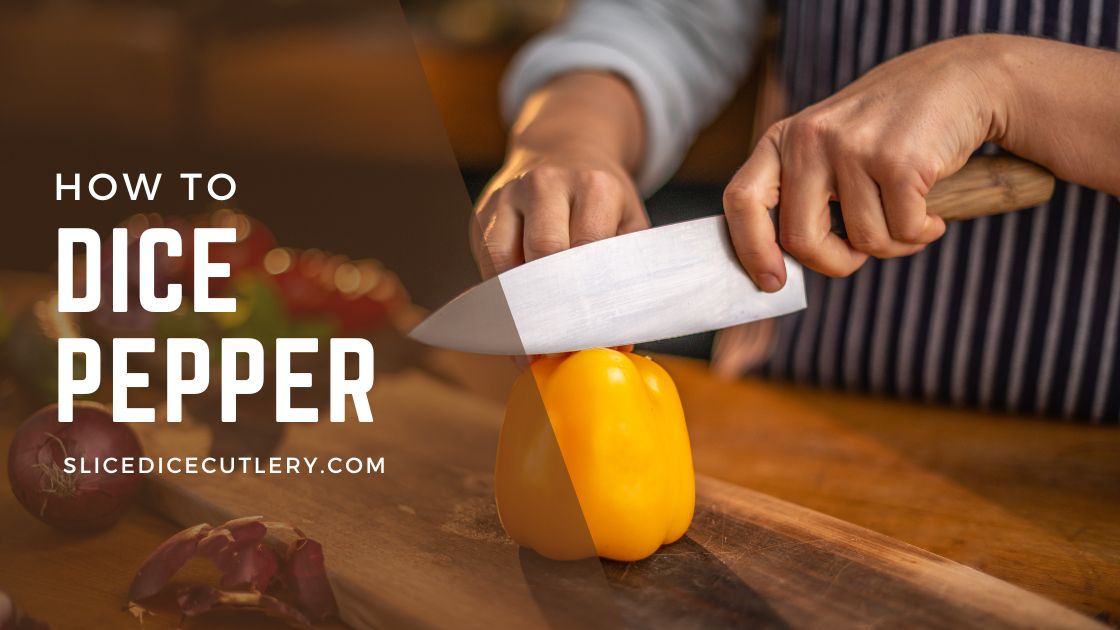How to Dice a Pepper fast and easy? If you use peppers in the kitchen, then learning how to dice a pepper is essential. Whether sliced into rings, matchsticks, or fine dice, these sweet, zingy veggies are a vital ingredient of chilis, stir-fries, omelets, sauces, salsa, crudité plates, and more.
As you can see, mastering dicing a pepper will make life much simpler and your cooking all the more efficient. If you love your peppers, then good for you, peppers are rich in antioxidants, which are associated with better health and protection against conditions like heart disease and cancer.
For instance, peppers are especially rich in antioxidant vitamins, including vitamins C, E, and beta-carotene. In other words, if you aren’t consuming peppers, you should. Safe to say, peppers offer a whole lot of goodness; however, dicing them is a whole other situation.
Peppers can appear difficult to dice; most people get intimidated due to their unusual shape and number of seeds. That said, dicing peppers doesn’t need to be scary once you learn the right technique. So if you are thinking about dicing peppers and don’t want to waste any edible sections, discover ways to dice a pepper for your next recipe.
How to Dice a Pepper
Tools
- Sharp chef’s knife
- Cutting board
Instructions
- Place a clean cutting board on a flat surface
- Using the cutting board and chef knife, cut the stem off your pepper
- Place the pepper in the center of the cutting board with the stem side down.
- Beginning as close to the center of the bottom of the pepper as possible, cut down to slice off a segment, avoiding white flesh, seeds, and the stem on the far side
- Cut off the remaining segments using the same method
- Set the cut segments off to the side of the cutting board.
- Face the segments skin side down, top to bottom, on the cutting board.
- Line up your knife lengthwise with one segment.
- Move the knife about ¼” into the pepper segment.
- Cut down lengthwise to create a ¼” strip.
- Cut all the segments into ¼” strips in this fashion.
- Gather the strips together into a bundle.
- Place the bundle on the cutting board, stretching left to right
- Hold the bundle down with one hand and cut about a ¼” section off the tips of the strips to dice the pepper.
- Continue cutting off ¼” sections of the strips until you reach the end of the strips.
Common Question About How to Dice a Pepper
How do you quickly dice bell peppers?
- When cutting bell peppers into large or small dice, start by cutting 1/2″ off the top and bottom of the bell pepper. For small dice, you can use these parts, too.
- Cut two vertical slits through the flesh of the bell pepper
- Open the pepper and use the knife to remove the core; discard
- Lay the pepper halves on the cutting board, skin-side down, and use a sharp knife to cut them into strips
- Rotate the pieces by 90 degrees and cut the strips into whatever size dice you wish.
For a higher yield, dice the ends of the pepper as well.
How to use diced peppers?
Diced bell pepper goes right into all sorts of recipes, especially egg dishes, like omelets. Diced bell peppers are also part of the mirepoix for soups or stews, especially in Creole cuisine.
Is it ok to freeze diced peppers?
Absolutely! Chop into your desired cut, then flash freeze on sheet pans and store in an airtight, freezer-safe container. They’ll stay nice for up to six months. In the regular fridge, they are good for about three days.
How do you cube peppers?
- Wash the bell pepper first, then slice in half through the stem
- Slice around the stem on both halves to remove the seed bundle
- Lean a halve on its long edge and slice off a thin wedge. For a standard dice, around 1/8″-1/4″ is what you’re looking for.
- Continue slicing, leaning the pepper over slightly after each slice to maintain uniformity.
- Group the slices into a bundle
- Pointing the bundle towards your knife, slice to about the same width as your previous cuts
How do your core and dice a pepper?
- Using a large chef’s knife, slice straight down on each side to form 4 straight pieces of the pepper. This keeps the seeds and ribs intact in the center.
- Slice off the bottom and top of the pepper, and pull out the stem
- Place the skin side of the pepper down, and cut it into large slices
- Turn the slices and cut them crosswise to make square pieces
How do you slice green peppers?
- Lay the bell pepper on its side on a cutting board
- Use a knife to slice off the top, stem-end of the bell pepper
- Then place the flat or cut-side end of the bell pepper flat on the cutting board, and make four downward cuts, separating the pepper flesh from the white inner core
- Discard the core
- Then thinly slice the bell pepper into long strips.
Is there a special knife to dice a pepper?
A sharp chef knife is ideal for this project because sharp knives make cleaner, quicker cuts and are therefore safer, as well as the length of a chef knife easily spans the width of a pepper. However, any sharp, long knife would also work if you do not own a chef knife.
What to look for in a knife?
One with a blade, bolster, and tang forged from a single piece of high-carbon stainless steel; has optimal stability. You should see the tang (or metal) sandwiched between the handle material along the spine.
Also, the knife should be neither blade- nor handle-heavy: If you place your finger under the curve of the bolster, the knife should balance perfectly.
What is the best chef knife to dice a pepper?
Here is an excellent choice:
Misono UX10 Gyutou 8.2″
This knife will cut anything like its butter but excels at slicing and dicing. Stain-resistant chef knife has an asymmetrical edge to grant the knife sharp and even edges. It is Misono’s top-of-the-line knife made with Swedish steel, size 8.2″ inches.

Features:
- Steel Type: Swedish Stain-Resistant Steel
- Blade: Double-Edged
- Handle Material: Composite Wood
Additional Tips on How to Dice a Pepper
- A cutting board is preferable to cut on because it is built to handle knives and repeated use. However, any flat surface you are comfortable cutting on is acceptable.
- Remember that a sharp blade is a key to any knife technique. You don’t need the most expensive knife, but you should learn to care for your knife and keep it sharp.
- Once you cut into the pepper, you can see the white flesh and seeds. The indented portions of the pepper are where the white membranes and seeds attach.
- It is best to make a small cut, look into the pepper to see where the seeds and inedible sections are, then cut around them as you cut toward the stem. This will allow you to cut the portions you want to eat while keeping the undesirable sections together.
- Once you cut off one segment, it becomes easy to see the seeds and membranes and cut them around for the remaining segments.
- The fleshy side of the pepper is easier to cut into, so you can control how quickly your knife cuts through the pepper and avoiding hurting yourself.
- Make sure the tips of the strips are lined up evenly on the cutting board so that your pieces will all be the same size when you dice.
What Is The Difference From Dicing Peppers To Dicing Jalapenos
Dicing peppers and jalapenos involves similar techniques, but there are a few key differences due to the size, shape, and heat of the two types of peppers.
Bell Peppers:
- Bell peppers are larger and more rounded than jalapenos, which makes the dicing process slightly different.
- To dice bell pepper, you typically cut off the top and bottom, remove the seeds and membrane, flatten out the pepper, and then cut it into strips before dicing.
- Bell peppers are not spicy, so you don’t need to worry about handling them with gloves or avoiding touching your eyes after cutting them.
Jalapenos:
- Jalapenos are smaller and more elongated than bell peppers.
- To dice a jalapeno, you typically cut off the stem end, slice it in half lengthwise, remove the seeds and membranes (if you want less heat), and then cut the halves into strips before dicing.
- Jalapenos are spicy, so handling them with gloves or washing your hands thoroughly after cutting them is recommended to avoid any discomfort.
While the basic technique of dicing is the same for both types of peppers, the main differences lie in the initial preparation and handling due to the peppers’ size, shape, and heat level.



